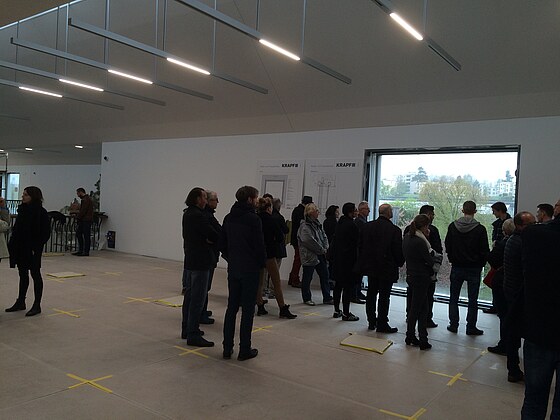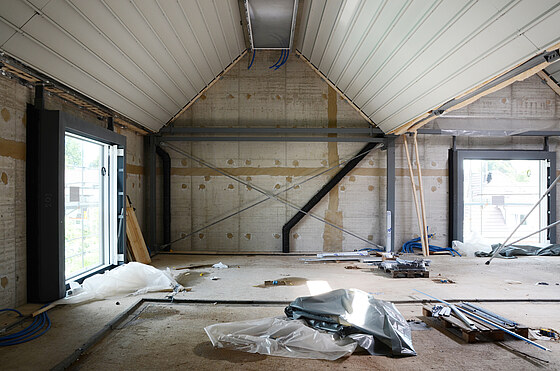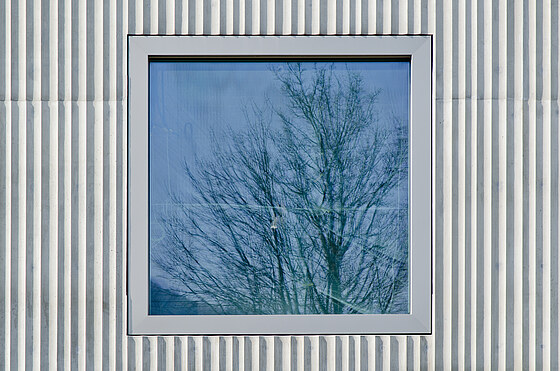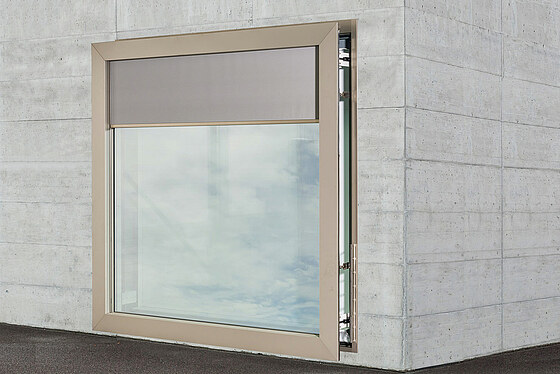



Just 185 days to go before the new Natural History Museum in St. Gallen opens its doors
On 18 April, 70 architects from Architektur Forum Ostschweiz visited the construction site. “The interior is coming along well, with spatial impressions changing from day to day. There is a mix between the charm of a construction site and that of the final end building.”
Special solution with parallel hinged windows
When architects look for new aesthetic and functional expressions, innovative solutions are required, as well as reliable partners. Krapf AG happily accepts and commits itself to such challenges. Krapf AG impressed both the architects and the St. Gallen Building Department with its special solution. This unique window façade development, which combines a sophisticated metal and mechanical engineering construction, was planned and constructed by the Krapf team and assembled by our fitters.
Requirement profile
The parallel hinged windows have to perform two functions: smoke and heat extraction and ventilation. The challenge lay in the size and the sheer weight of the windows and the impermeability requirement. In addition to 18 fixed glazed elements, the order included 24 motorised hinged windows of 1.8 m x 1.8 m and 3.7 m x 3.7 m, and weighing up to 2,000 kg. A blower door test had to be taken to achieve the Minergie-P label. Reflecting the value of the exhibits on display, the windows are made to intruder resistance class RC2. Contact strips on the sealing edges and an emergency stop button guarantee personal safety. The position of the window is monitored by the building control system through break contacts.
Technology
The opening mechanism of the window is based on the drawer system. The full weight of the window pane of up to one tonne is transferred to the frame structure by means of four telescopic fittings. Two fittings are positioned in the vertical axis on the left and right. These high quality, smooth-running industrial bearings also permit manual opening and closing. The drive mechanism has two perfectly synchronous spindle drives. The motors are located vertically on either side in the middle and connected to the window through a mechanism with pivot bearings at the top and bottom. With this mechanism, the window pane is held at four points, providing maximum stability and preventing tilting even at a height of 3.7 m. In addition, the self-locking mechanism significantly increases protection against intrusion. The complete drive mechanism is integrated into the reversible soffit and is not visible. Impermeability of 100% with sufficient positioning tolerance is achieved through circumferential gate seals on the glass and frame inside and out.
Sun and light protection
The exterior shading travels with the window pane and can be operated at each position. An aluminium frame seals the window from the outside and covers the shading. Black-outs with ZIP system and guide rails – depending on the geographical orientation – are integrated into the soffit on the interior. Thus, the lighting conditions in the building can be individually controlled. This individual control is particularly important for a daylight museum. “For the exhibits on display, daylight is not optimal,” explains Toni Bürgin, director of the museum. “Therefore, we have to incorporate special UV protection into the window panes.” Daylight gives the museum a bright, modern feel and is a requirement of the energy-efficient Minergie-P-Eco standard. The solution from Krapf AG accommodates the different requirements.
Assembly
The elements were produced and assembled at our works in Engelburg, Switzerland. The window pane and frame are fitted with all the components and prepared logistically, ready for use. At the construction site, the finished elements were lowered by crane between the scaffolding and the façade. Inside, a crawler crane with a special suction system and a lifting capacity of 2.5 tonnes lifted the elements obliquely into the interior and positioned them in place. This required maximum concentration as the opening in the finished concrete façade had an air gap of only 20 mm. The Krapf team is proud and excited about this accomplished project.
Project Manager:
Thomas Bechtiger
Metal and façade construction services, Krapf AG
- 24 motorised parallel hinged windows, smoke and heat extraction/ventilation / RC2 / weight up to 2 tonnes
- 18 fixed glazed elements
- Textile exterior shading
- Internal, integral black-out
- Aluminium exterior doors
- Energy requirements: Minergie-P Eco, blower door test
Building owner:
Hochbauamt der Stadt St.Gallen
Architect:
Armon Semadeni, Zürich